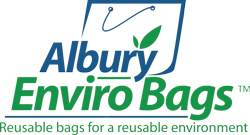Reusable bags are made from a wide variety of materials and fabrics. In truth, there isn’t one type of material that is best because each material carries its own advantages and disadvantages. The best reusable bag depends on what you’re looking for. Some are easier to clean while others are slightly more softer or more durable. To help you pick the best reusable bag for your needs, we’ve put together a guide of the different material options to help with your decision.
Cotton
Cotton reusable bags come in many variations. Organic cotton is grown without pesticides and is typically certified using global standards. Recycled cotton consists of reclaimed cotton scrap, which is reclaimed or spun into new yarn. Traditional cotton production involves a raw, natural fibre, but requires more chemicals than any other crop.
Advantages:
- Biodegradable as a natural plant fibre
- Renewable resource
- Strong and durable
- Soft, smooth and pleasant to the touch
- Widely available in Australia
- Can be machine washed, with similar colours, in cold water. We recommend air drying to reduce shrinkage and to preserve the longevity of any printing.
Disadvantages:
- Not moisture resistant unless chemically treated
- High water consumption crop
- Traditional (non-organic) cotton accounts for 16% of the world’s pesticides
- Heavy, bulky and expensive to ship
- As with anything made from 100% cotton, bags can shrink and wrinkle with machine washing (to limit this, wash in cold water and air dry).
Cotton is the ideal material for logo printing on reusable bags. In addition to screen printing and full colour heat transfer printing, some custom cotton bags can also be printed in full bleed. This makes cotton ideal for those looking to print complex designs that want to ensure look amazing.
Jute
Jute is the second-largest crop in the world grown for fibre (after cotton) and it grows almost as fast as hemp; it’s ready for harvest four to six months after planting and produces 50 to 100 tonnes per acre. Also, each hectare of jute captures up to 15 tonnes of CO2 and releases up to 11 tonnes of oxygen.
Advantages:
- Natural renewable resource
- Jute is biodegradable and compostable
- Cultivated
- Durable
- Requires little to no pesticides or irrigation
- Can be blended with other fabrics (like nonwoven polypropylene)
Disadvantages:
- Not very resistant to moisture unless chemically treated or laminated
- Grainy texture
- Printing limited to thick lines and bold objects (no fine details)
Clean Up Australia supports jute as the best replacement for plastic bags, as does the City Of Sydney.
Hemp
Hemp grows well without pesticides or fertilisers and is drought tolerant. Each acre yields three to six tonnes of dry fibre. Hemp fibers are one of Earth’s longest, strongest and most durable fibers and are several times stronger than cotton.
Advantages
- Extremely strong, durable, and rot resistant
- Can grow in poor soils with little water
- Refined hemp is soft, smooth and pleasant to touch
- Most hemp reusable bags can be machine washed and dried
- Hemp gets stronger over time and ‘breaks in’ nicely when used frequently
Disadvantages:
- Can be expensive
- Can be grainy, though most is refined. Refined hemp uses a fair amount of water
Hemp can be blended with other materials to make highly desirable, high end fabrics with texture similar to linen. For example, hemp is often blended with cotton or recycled PET.
H2: Get in Touch Today for Quality Reusable Shopping Bags
At Albury Enviro Bags, we have Australia’s best range of customisable jute, cotton and hemp bags. These are available in a wide range of colours and styles and are printed perfectly and delivered on-time, every time. Explore our range by material or by bag style or contact our team today to find out more.





